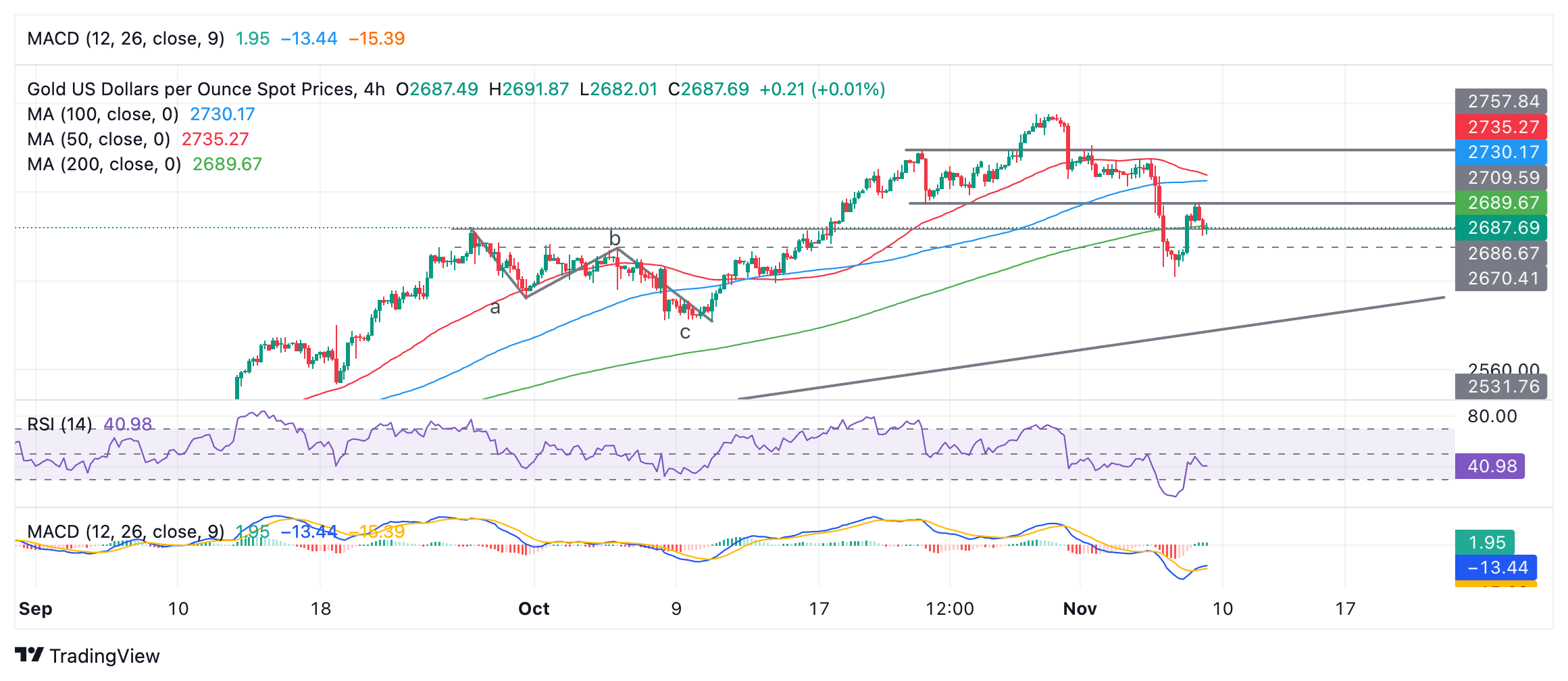- Gold falls on Friday as Donald Trump’s re-election continues to impact the precious metal.
- This reverses a short-term bounce following the Federal Reserve’s decision to cut interest rates by 0.25%.
- Technically, XAU/USD corrects back within a short-term downtrend.
Gold (XAU/USD) edges down to trade around the $2,690 mark on Friday, extending the short-term bearish mini trend it has been in since it rolled over on Halloween. The decline comes amid market expectations that President-elect Donald Trump’s economic policies will be positive for the US Dollar (USD), as higher tariffs and tax cuts could keep interest rates high, supporting foreign capital inflows into the US currency. This, in turn is expected to pressure Gold lower since it is mainly priced and traded in USD.
Gold further dips after the preliminary release of the Michigan Consumer Sentiment Survey rose to 73 in November from 70.5 in October, and above expectations of 71. This is likely to contribute to lifting expectations for interest rates in the future which is negative for Gold, a non-interest bearing asset.
Gold bounces briefly after Fed meeting
Gold reverses its brief bounce after the US Federal Reserve (Fed) November rate meeting concluded with the decision to cut interest rates by 25 basis points (bps) (0.25%) on Thursday. This brought the Fed Funds Target Range (FFTR) down to the range of 4.50% - 4.75%, as expected. Lower interest rates are positive for Gold, which is a non-interest-bearing asset, as they reduce the opportunity cost of holding the precious metal.
Gold also won bids due to the complete absence of any mention of how the outcome of the US presidential election might impact the US economy in the Fed’s accompanying statement. Nor was the wording changed by much from the previous meeting, except to state that “labor market conditions have generally eased” since the last meeting in September.
During his press conference, Fed Chairman Jerome Powell deflected question about Trump’s policies, saying it was too early to give an assessment given he did not know the “timing, (or) substance of policy changes.” Powell also said he did not think the rise in US Treasury bond yields was due to higher inflation expectations, perhaps signaling a gloomier assessment that might benefit safe-haven Gold.
Gold weakens after Donald Trump wins election
Gold's steep decline on Wednesday was triggered by the results of the US presidential election, which increasingly confirmed a return to the White House for former president Donald Trump. The newly-elected president’s economic agenda supports a higher US Dollar, which is negative for the precious metal.
Gold may have been further hit by a broad rotation out of safe-haven investments and into alternative, riskier assets, such as Bitcoin (BTC) and equities, as a result of Trump’s re-election.
Bitcoin hit a new all-time high on Thursday due to expectations that Trump will relax crypto regulation. Stocks also rose as a result of anticipated tax cuts and a looser regulatory environment overall. These all came at the cost of Gold, which saw outflows as investors shuffled their portfolios.
Trump’s claims that he can end the conflicts in the Middle East and Ukraine, though seemingly exaggerated (“I will have that (Ukraine-Russia) war settled in one day – 24hrs,” Trump said once), probably reduced safe-haven flows and also hit Gold. Even before Trump’s re-election, the US had bolstered its military presence in the region with B-52 bombers designed to act as a deterrent to any plans Iran might have for attacking Israel after its bombardment last month.
Technical Analysis: XAU/USD pulls back within short-term downtrend
Gold pulls back higher after finding a floor following the post-Trump election. The correction is likely to be temporary, however, given the precious metal remains in a short-term downtrend, and it is a principle of technical analysis that “the trend is your friend.”
XAU/USD 4-hour Chart
The Relative Strength Index (RSI) momentum indicator has exited oversold territory, advising short-holders to close their trades and open tentative longs. The Moving Average Divergence Convergence (MACD) indicator has crossed above its signal line, giving a buy signal. This suggests a risk the correction may still have higher to go.
However, due to the bearish short-term trend, the odds currently favor Gold eventually turning back down again. A break below the $2,643 low of Thursday would confirm a continuation to the downside, probably to the next target and the trendline for the long-term uptrend at $2,605.
However, the precious metal remains in an uptrend on a medium and long-term basis, with a material risk of a reversal higher in line with these broader up cycles at some point in time.
Economic Indicator
Michigan Consumer Sentiment Index
The Michigan Consumer Sentiment Index, released on a monthly basis by the University of Michigan, is a survey gauging sentiment among consumers in the United States. The questions cover three broad areas: personal finances, business conditions and buying conditions. The data shows a picture of whether or not consumers are willing to spend money, a key factor as consumer spending is a major driver of the US economy. The University of Michigan survey has proven to be an accurate indicator of the future course of the US economy. The survey publishes a preliminary, mid-month reading and a final print at the end of the month. Generally, a high reading is bullish for the US Dollar (USD), while a low reading is bearish.
Read more.Last release: Fri Nov 08, 2024 15:00 (Prel)
Frequency: Monthly
Actual: 73
Consensus: 71
Previous: 70.5
Source: University of Michigan
Consumer exuberance can translate into greater spending and faster economic growth, implying a stronger labor market and a potential pick-up in inflation, helping turn the Fed hawkish. This survey’s popularity among analysts (mentioned more frequently than CB Consumer Confidence) is justified because the data here includes interviews conducted up to a day or two before the official release, making it a timely measure of consumer mood, but foremost because it gauges consumer attitudes on financial and income situations. Actual figures beating consensus tend to be USD bullish.
Information on these pages contains forward-looking statements that involve risks and uncertainties. Markets and instruments profiled on this page are for informational purposes only and should not in any way come across as a recommendation to buy or sell in these assets. You should do your own thorough research before making any investment decisions. FXStreet does not in any way guarantee that this information is free from mistakes, errors, or material misstatements. It also does not guarantee that this information is of a timely nature. Investing in Open Markets involves a great deal of risk, including the loss of all or a portion of your investment, as well as emotional distress. All risks, losses and costs associated with investing, including total loss of principal, are your responsibility. The views and opinions expressed in this article are those of the authors and do not necessarily reflect the official policy or position of FXStreet nor its advertisers. The author will not be held responsible for information that is found at the end of links posted on this page.
If not otherwise explicitly mentioned in the body of the article, at the time of writing, the author has no position in any stock mentioned in this article and no business relationship with any company mentioned. The author has not received compensation for writing this article, other than from FXStreet.
FXStreet and the author do not provide personalized recommendations. The author makes no representations as to the accuracy, completeness, or suitability of this information. FXStreet and the author will not be liable for any errors, omissions or any losses, injuries or damages arising from this information and its display or use. Errors and omissions excepted.
The author and FXStreet are not registered investment advisors and nothing in this article is intended to be investment advice.
Recommended content
Editors’ Picks

EUR/USD dips below 1.1000 as Trump authorizes 90-day pause on tariffs
EUR/USD retreated below the 1.1000 mark on headlines indicating that United States President Donald Trump authorized a 90-day pause on non-retaliating countries. The pause applies to reciprocal and 10% tariffs, effective immediately, according to a Truth Social post. FOMC Minutes indicated increasing uncertainty.

GBP/USD eases further on tariffs pause announcement, USD still weak
GBP/USD's correction seems to have met a decent contention around the 1.2750 zone so far on Wednesday, as investors continue to assess the ongoing US-China trade war. US doubles the bet, announced 125% levies on Chinese imports.

Gold recedes to $3,050 on Trump's headlines
Gold prices now give away part of their advance and revisit the $3,050 zone per troy ounce after President Trump announced a 90-day pause on reciprocal and 10% tariffs. FOMC Minutes passed unnoticed as optimism returned.

Dow Jones Industrial Average rockets 6% higher on tariff suspension
The Dow Jones Industrial Average (DJIA) skyrocketed on Wednesday, surging over 6% on the day and returning to the 40,000 handle after the Trump administration announced yet another pivot on its own tariff policies.

Tariff rollercoaster continues as China slapped with 104% levies
The reaction in currencies has not been as predictable. The clear winners so far remain the safe-haven Japanese yen and Swiss franc, no surprises there, while the euro has also emerged as a quasi-safe-haven given its high liquid status.

The Best brokers to trade EUR/USD
SPONSORED Discover the top brokers for trading EUR/USD in 2025. Our list features brokers with competitive spreads, fast execution, and powerful platforms. Whether you're a beginner or an expert, find the right partner to navigate the dynamic Forex market.




